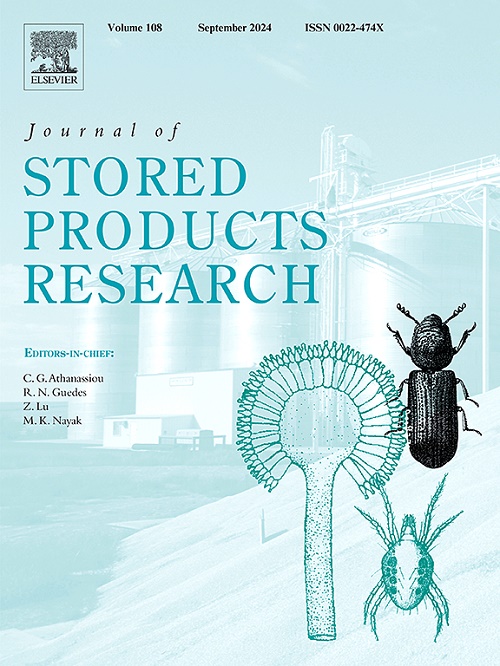Chemical profile, insecticidal and repellent activities of four underexplored Moroccan essential oils against Sitophilus oryzae
IF 2.7
2区 农林科学
Q1 ENTOMOLOGY
引用次数: 0
Abstract
This study aims to evaluate the chemical composition and insecticidal and repellent effects of essential oils (EOs) extracted from four underexplored Moroccan plants, i.e., Deverra denudata, Micromeria macrosiphon, Ruta angustifolia, and Thymus riatarum, against the rice weevil Sitophilus oryzae. The chemical composition of the EOs was determined through gas chromatography-mass spectrometry (GC-MS) analysis. Moreover, the insecticidal effect was assessed through fumigant and contact assays, while the repellent effect was evaluated using the area preference assay. Regarding the chemical composition, α-pinene (42.7%) and β-pinene (40.5%) were the major compounds of D. denudata EO, while bornyl acetate (30.2%), borneol (20.4%), and camphor (12.5%) dominated in M. macrosiphon EO. Regarding R. angustifolia EO, 2-undecanone (90.2%) and 2-decanone (7.5%) were identified as the main constituents. Finally, T. riatarum EO was dominated by p-cymene, carvacrol, and borneol in percentages of 26.8, 25.0, and 13.5%, respectively. Regarding the fumigant toxicity, all EOs displayed strong efficacy after 72 h of exposure with LC50 values comprised between 73.9 and 85 μL/L of air, and D. denudata EO appeared to be the most toxic. Regarding the contact toxicity, all EOs exhibited a strong effect, where R. angustifolia EO was the most toxic after 24 h (LC50 of 0.13 μL/insect), and M. macrosiphon after 72 h (LC50 value of 0.08 μL/insect). On the contrary, T. riatarum EO exhibited the highest percentages of repellence (PR of 92%) at the lowest concentration (0.019 μL/cm2) after 30 min, while R. angustifolia EO after 4 h (PR of 90%) at (0.019 μL/cm2). Finally, for the long-term exposure (24 h), T. riatarum exhibited the highest PR of 86 and 94% at 0.019 μL/cm2 and 0.156 μL/cm2, respectively. Overall, our study has reported for the first time the insecticidal and repellent effects of EOs from the four Moroccan plants against the rice weevil S. oryzae, underscoring their potential as efficient bio-insecticides for the management of stored product pests.

求助全文
约1分钟内获得全文
求助全文
来源期刊
CiteScore
5.70
自引率
18.50%
发文量
112
审稿时长
45 days
期刊介绍:
The Journal of Stored Products Research provides an international medium for the publication of both reviews and original results from laboratory and field studies on the preservation and safety of stored products, notably food stocks, covering storage-related problems from the producer through the supply chain to the consumer. Stored products are characterised by having relatively low moisture content and include raw and semi-processed foods, animal feedstuffs, and a range of other durable items, including materials such as clothing or museum artefacts.

 求助内容:
求助内容: 应助结果提醒方式:
应助结果提醒方式:


